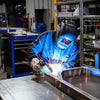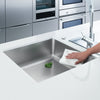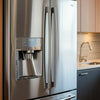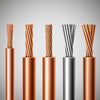
5 Points Tell You Why Manual Machining Still Dominates in the Age of CNC Precision
The Unreplaceable Value of Manual Skills in Digital Manufacturing
Walk into any CNC machine factory, and you’ll see lines of CNC machines well-organized operation. Yet in the corners are benches where master craftsman no robot can replace. Different with predictions of total automation, 73% of high-precision manufacturers retain specialized manual department—not to commemorate the spirit of craftsmanship, but it has a key factor to improve product precision. In aerospace, medical and automatic industrial, these experts deliver what machines cannot.

What is chromate conversion, this blog is enough.
Chromate conversion is a kind of chemical conversion coating. When we put metal parts into the acidic chemical solution(contains chromate), the metal surface will form a thin coating. This coating does not react with most things, thereby it can improving corrosion resistance of substrate and enhancing coating adhesion.

CNC Machining Replaces Traditional Machining Methods, have Efficiency Really been Enhanced?
In today's world, when people talk about machining, they often think of CNC rather than traditional machine. However, are traditional machines facing the fate of being eliminated? How efficient are traditional machines in the CNC times? I will analyze the differences between traditional machines and CNC from the accuracy, cost, and automation degree, as well as their current application scenarios.

CNC Milling vs Turning: The Ultimate Precision Manufacturing Key In CNC Machining
Why Understanding the Difference Matters
Choosing between CNC milling and turning isn’t about finding a "better" process—it’s about matching the technology to your part’s geometry, material, and functional requirements. Milling excels at complex 3D contours and asymmetric features, while turning dominates for cylindrical symmetry and rotational precision. Misapplying these methods leads to:
-
50–70% higher machining costs from inefficient material removal
-
Dimensional inaccuracies due to improper toolpath forces
-
Extended lead times from unnecessary setups or rework
Understanding their core differences unlocks faster production, tighter tolerances, and 20–30% cost savings.

Beyond Machining Marks: The Surface Treatment Showdown for CNC Parts
Why Surface Treatment Matters More Than You Think
CNC-machined parts rarely perform optimally straight off the machine. Raw surfaces retain visible tool marks (Ra 1.6–6.3 μm), creating stress concentration points that reduce fatigue life by 15–30% . Post-processing eliminates these flaws while adding critical functionality: corrosion resistance, wear protection, aesthetic appeal, or dimensional stability. Selecting the wrong finish risks part failure, unnecessary costs, or rejected designs.

The Science of Grit Size in Sand Blasting: Precision Surface Engineering
Why Grit Size Dictates Your Surface Finish
Grit size in abrasive blasting isn't just a number—it’s the primary lever controlling surface texture, fatigue resistance, and coating adhesion. Smaller grits (e.g., #220) deliver fine finishes but remove material slowly, while coarser grits (e.g., #60) aggressively shape edges yet risk dimensional inaccuracy. The physics is clear: finer particles increase surface contact points per square inch, enabling uniform peening and residual stress control. However, excessively fine grits (≤50µm) can cause agglomeration, leading to inconsistent impact energy distribution.

Aluminum 6061 vs 7075: The Definitive Guide to Choosing Your Alloy
Introduction: The Critical Crossroads
In precision engineering, selecting the right aluminum alloy can mean the difference between optimal performance and catastrophic failure. 6061 and 7075 – two of the most widely used alloys – sit at opposite ends of the aluminum spectrum. While 6061 offers versatility and economy, 7075 delivers aerospace-grade strength. Yet misapplying either can lead to costly redesigns, premature failures, or bloated budgets.

Demystifying Surface Roughness Value: The Key to Functional Precision
Why Surface Roughness Matters
Surface roughness quantifies microscopic peaks and valleys on machined parts. It directly impacts:
-
Functional Performance: Friction, wear, sealing, lubrication retention
-
Aesthetics: Visual appearance and light reflection
-
Manufacturing Cost: Finer finishes require additional operations (grinding, polishing)





